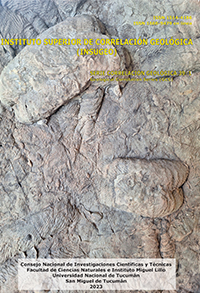Serie Correlación Geológica 39 (1)
First record of the fossil bee nest Elipsoideichnus meyeri from Argentina (Colón, Entre Ríos province)
Carlos A. Console Gonella | Mariano Verde | Silvina De Valais | Sebastián Apesteguía | Ignacio Díaz Martínez | Pablo A. Gallina | Federico A. Gianechini | Paolo Citton | Florencio Gilberto Aceñolaza
Descargar trabajo en formato PDFResumen
PRIMER REGISTRO DEL NIDO DE ABEJA FÓSIL ELIPSOIDEICHNUS MEYERI DE ARGENTINA (COLÓN, PROVINCIA DE ENTRE RÍOS). Se presenta el primer registro de la traza fósil Elipsoideichnus meyeri Roselli, 1987, de afloramientos de la cantera Prefectura Naval Argentina, Parque Nacional El Palmar, Colón (provincia de Entre Ríos), Argentina. E. meyeri consiste en un nido de abeja fósil helicoidal, hasta la fecha solo registrado en la Formación Asencio (Cuenca Norte) del suroeste de Uruguay. El nuevo espécimen fue encontrado en rocas tradicionalmente asignadas a la Formación Puerto Yeruá (Cuenca Chaco Paraná), consideradas del Cretácico Superior sobre la base del contenido paleontológico de estratos correlativos en el área, conformado por restos de dinosaurios y plantas. Sin embargo, el marco estratigráfico más confiable para la localidad de estudio debería mantener los nombres litoestratigráficos de la Cuenca Norte de Uruguay, siendo el principal argumento para la presencia de una discordancia regional entre las formaciones Guichón y Mercedes, lo que imposibilita la asignación de este nuevo registro a la Formación Puerto Yeruá. Las facies observadas y este nuevo registro en sí permitieron la asignación preliminar de los estratos portadores de E. meyeri de la Prefectura Naval Argentina a la Formación Asencio, reforzado por el registro que aquí se presenta ya que no existe evidencia tafonómica que apoye un transporte significativo horizontal o vertical del mismo. Sobre la asignación cronoestratigráfica de este registro, no existen elementos concluyentes para ubicarlo dentro del Cretácico Superior o Eoceno, siendo un hecho aún en análisis. Este registro amplía la distribución geográfica de este icnotaxón, permitiendo el desarrollo de nuevas investigaciones en el área, reabriendo interrogantes relacionados con la paleobiología y la cronoestratigrafía de abejas antiguas en esta zona del sur de América del Sur.
Abstract
We present the first record of the trace fossil Elipsoideichnus meyeri Roselli, 1987, from outcrops of the Prefectura Naval Argentina quarry, Parque Nacional El Palmar, Colón (Entre Ríos province), Argentina. E. meyeri consists of a singular helicoidal fossil bee nest, to date only recorded from the Asencio Formation (Norte Basin) of southwestern Uruguay. The new specimen came from rocks traditionally assigned to the Puerto Yeruá Formation (Chaco Paraná Basin), considered Upper Cretaceous in age based on paleontological content of correlative strata in the area, composed of dinosaur and plant remains. However, the most reliable stratigraphic framework for the studied locality should keep the lithostratigraphic names of the Norte Basin of Uruguay, being the main argument for the presence of a regional unconformity between Guichón and Mercedes formations, which precludes the assignment of this new record to the Puerto Yeruá Formation. Observed facies and this new record itself allowed the preliminary assignation of Prefectura Naval Argentina E. meyeri-hosting strata to the Asencio Formation, which is reinforced by the record presented here itself due to there are no taphonomic evidence supporting significant transport horizontally or vertically. About the chronostratigraphic assignment of this record, there are no concluding elements to locate it within the Upper Cretaceous or Eocene, being a matter of fact and still in flux. This record expands the geographical distribution of this ichnotaxon, allowing the development of further research in this area and, re-opening questions related to the palaeobiology and chronostratigraphy of ancient bees in this area of southern South America.






